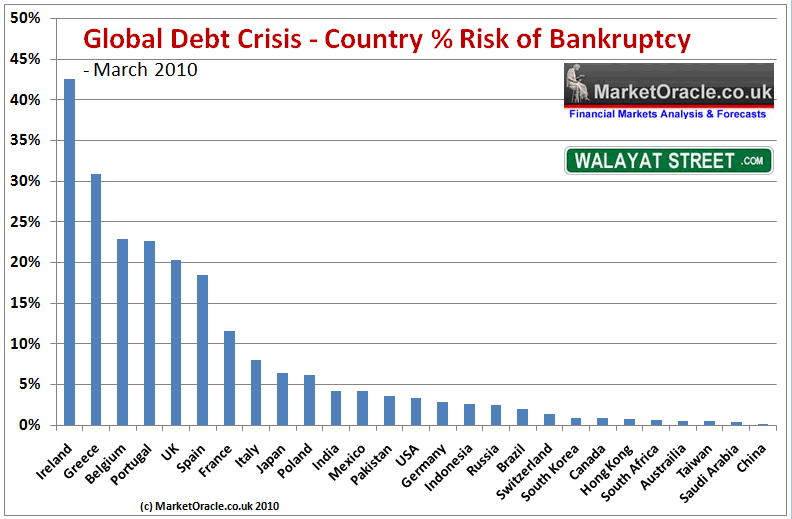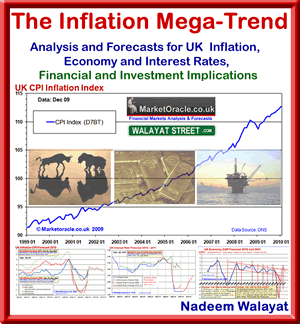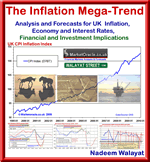Global Sovereign Debt Crisis, Country Bankruptcy Relative Risk of Default
Interest-Rates / Global Debt Crisis Mar 30, 2010 - 12:47 AM GMTBy: Nadeem_Walayat
 All countries are on the path towards bankruptcy, to measure where a country stands along this path it is critical to look beyond official statistics that focus primarily on public sector net debt and the annual budget deficit in terms of % of GDP.
All countries are on the path towards bankruptcy, to measure where a country stands along this path it is critical to look beyond official statistics that focus primarily on public sector net debt and the annual budget deficit in terms of % of GDP.
The key item missing from most commentary on this subject matter is debt and liabilities that are denominated in foreign currencies as that can mask a stealth trend towards potentially imminent bankruptcy that can suddenly blow up in the face of a countries citizens who had been previously mislead by official statistics into thinking that the debt situation was under control, much as Icelanders experienced during 2008 where one day they enjoyed one of the highest standards of living amongst westerners to next day wake up to be bankrupt and poorer in terms of purchasing power than many third world countries. The key driver for state bankruptcy and currency collapse is the amount a country owes or is liable to foreigners, as debt denominated in foreign currencies cannot be inflated away as governments can do with domestic debt so it is one of the primary driving forces for a country going bankrupt as it is unable to meet the increasing interest payments due in foreign currency as its own currency falls.
The following graph attempts to paint an accurate picture of the current relative state of the trend towards bankruptcy of the worlds major economies which takes into account public and private debt, unfunded liabilities, budget deficits, and debt denominated in foreign currencies, as well as taking into account the historic track record of the countries in dealing with past debt crisis. The results are shown as a % of the countries risk of going bankrupt where Iceland would be at 100% following its defacto debt default.

Whilst the mainstream press these past two months has been obsessed with the Greek debt crisis, the above graph clearly illustrates that a far larger debt crisis looms in Ireland that could soon transplant Greece in the debt crisis headlines over the coming months, similarly a number of other Euro Zone countries head the risk towards bankruptcy league table with Belgium and Portugal not far behind Greece. The price that these countries pay for being stuck in the Euro single currency is that they cannot devalue to try and gain some competitive advantage for their economies and therefore try and grow and inflate their way out of a high debt burden that stifles economic activity.
However they also benefit from the fact that had they not been in the Euro then many of these countries would also be where Iceland is today as they would no longer be able to service the debt denominated in foreign currencies as their own currencies would have crashed as investors rush to the exit to preserve as much of the purchasing power of their investments into alternative currencies. The consequence of this in ability to devalue is deflationary as the economies contract in an attempt to reduce the debt burden and budget deficit as they attempt to move to a new sustainable equilibrium within the Euro block that demand greater competitiveness by means of reduction in costs i.e. by deflating wages, failure to do this results in higher interest rates and therefore a greater debt interest burden which again risks default.
The above graph puts Britain on a current 20% risk of going bankrupt i.e. defaulting on foreign debt, which whilst lower than the likes of Ireland, Greece, Belgium and Portugal, Britain is deemed to be of greater risk of bankruptcy than that of other oft mentioned PIIGS Spain and Italy, and significantly above that of the other large economies such as Germany, Japan and the United States.
Countries at higher risk of default can also be expected to experience relatively higher inflation rates as they attempt to competitively devalue their way out of the debt crisis, which is what Britain has been doing for the past 2 years that has seen the British Pound fall against the U.S. Dollar from £/$2.10 to £/$1.49 today, which is a devaluation of 30% and a devaluation against the Euro of 22%.
This also suggests that Euro block countries such as Ireland, Greece, Portugal and Spain will increasingly demand some sort of mechanism from within the Euro zone to achieve a similar competitive advantage outcome / debt financing other than the ongoing deflation. This could take the form of investment and subsidies to depressed regions of these countries, much as transpired when these countries originally joined the Eurozone, including the ECB buying PIIGS debt, the bill for all of which will ultimately be paid for by Germany as it is forced to distribute profits / gains from its competitive advantage as a consequence of the single currency that does not allow other countries to devalue and therefore unable to compete against Germany
One of the suggestions is that some of the PIIGS may leave the Euro. However I do not see how these countries can leave the Euro as that would immediately lead to a loss of confidence in the countries debt as investors would rush for the exit knowing full well that the countries currencies were destined to fall sharply under the weight of money that these countries would seek to print to attempt to inflate their way out of the the debt crisis, which would not work given the fact that a large proportion of the debts are denominated in Euro's against which their new floating currencies would more or less collapse. So, there is no chance of these countries leaving the Euro zone, not unless they are kicked out by the Germans due Germany being sick of bailing them out, which would imply a break up of the E.U., that I do not seek happening.
In terms of overall bankruptcy risk (defaulting to foreigners), many of the smaller euro zone countries stand at the extreme end of the bankruptcy spectrum, with the new emerging giants turning the tables on the western world that puts countries such as China at lower risk of default than even the United States. The graph also shows that much of the doom and gloom commentary in the mainstream press surrounding a debt crisis in the U.S. and Japan is not visible in the overall data, where the actual risk of bankruptcy and default remains low. Which is ironic when one considers that Japans public debt stands at 200% of GDP, compared to Irelands of 74%, which is due to the fact that Japan is able to finance its debt domestically due to the high savings rate in Japan which in fact also finances a large portion of U.S. debt, off course in the end Japan will still go bankrupt, even if it is able to continue pumping out more debt all the way up to and beyond 300% GDP.
In conclusion when investing or holding fiat paper such as bonds, investors need to evaluate the risks of a country defaulting as the higher the risk the more likely that countries debt (bonds) will lose value as the market will demand higher interest rates to finance the debt. Whilst countries at a lower risk of defaulting such as the emerging giant of China, represent a better risk for capital appreciation for investments made in that economy, especially for those that are investing from a high risk countries such as Britain i.e. currency advantage as discussed in the Inflation Mega-trend Ebook.
The full implications of the unfolding debt fuelled Inflation Mega-Trend including forecasts trends for major markets for many years are contained within the NEW FREE Inflation Mega-trend Ebook , which includes analysis and precise forecasts for:
 Interest Rates
Interest Rates
- Economy
- Inflation
- Gold & Silver
- Emerging Markets
- Stock Markets
- Stock Market Sectors and Stocks, including ETF's
- Natural Gas
- Agricultural Commodities
- House Prices
- Currencies
- Crude Oil
The 100 page ebook is being made available for FREE, the only requirement for which is a valid email address.
Source: http://www.marketoracle.co.uk/Article18273.html
By Nadeem Walayat
Copyright © 2005-10 Marketoracle.co.uk (Market Oracle Ltd). All rights reserved.
 Nadeem Walayat has over 20 years experience of trading derivatives, portfolio management and analysing the financial markets, including one of few who both anticipated and Beat the 1987 Crash. Nadeem's forward looking analysis specialises on UK inflation, economy, interest rates and the housing market and he is the author of the NEW Inflation Mega-Trend ebook that can be downloaded for Free. Nadeem is the Editor of The Market Oracle, a FREE Daily Financial Markets Analysis & Forecasting online publication. We present in-depth analysis from over 500 experienced analysts on a range of views of the probable direction of the financial markets. Thus enabling our readers to arrive at an informed opinion on future market direction. http://www.marketoracle.co.uk
Nadeem Walayat has over 20 years experience of trading derivatives, portfolio management and analysing the financial markets, including one of few who both anticipated and Beat the 1987 Crash. Nadeem's forward looking analysis specialises on UK inflation, economy, interest rates and the housing market and he is the author of the NEW Inflation Mega-Trend ebook that can be downloaded for Free. Nadeem is the Editor of The Market Oracle, a FREE Daily Financial Markets Analysis & Forecasting online publication. We present in-depth analysis from over 500 experienced analysts on a range of views of the probable direction of the financial markets. Thus enabling our readers to arrive at an informed opinion on future market direction. http://www.marketoracle.co.uk
Disclaimer: The above is a matter of opinion provided for general information purposes only and is not intended as investment advice. Information and analysis above are derived from sources and utilising methods believed to be reliable, but we cannot accept responsibility for any trading losses you may incur as a result of this analysis. Individuals should consult with their personal financial advisors before engaging in any trading activities.
Nadeem Walayat Archive |
© 2005-2022 http://www.MarketOracle.co.uk - The Market Oracle is a FREE Daily Financial Markets Analysis & Forecasting online publication.



